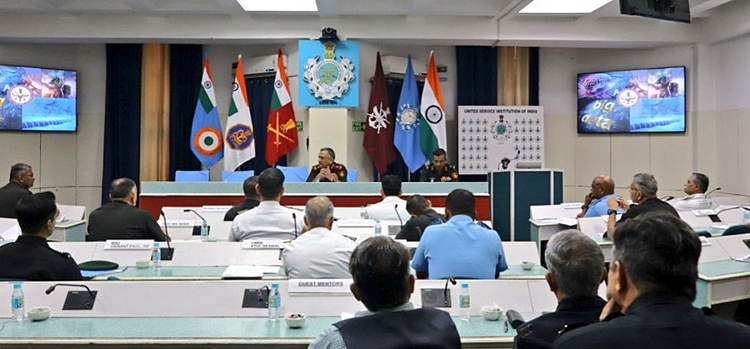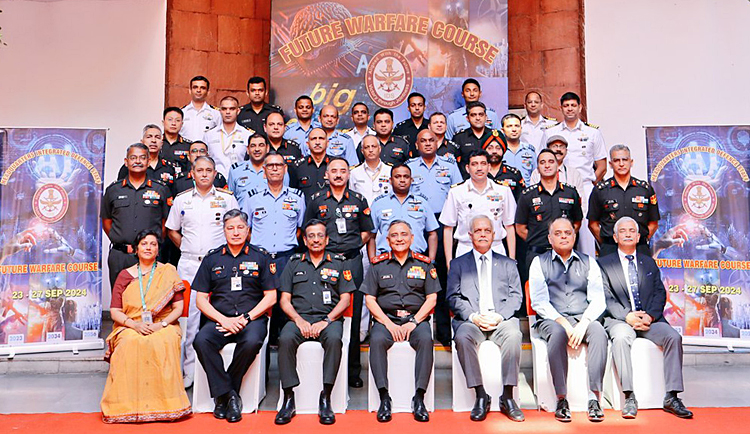INDIAN ARMED FORCES CHIEFS ON OUR RELENTLESS AND FOCUSED PUBLISHING EFFORTS

The insightful articles, inspiring narrations and analytical perspectives presented by the Editorial Team, establish an alluring connect with the reader. My compliments and best wishes to SP Guide Publications.

"Over the past 60 years, the growth of SP Guide Publications has mirrored the rising stature of Indian Navy. Its well-researched and informative magazines on Defence and Aerospace sector have served to shape an educated opinion of our military personnel, policy makers and the public alike. I wish SP's Publication team continued success, fair winds and following seas in all future endeavour!"

Since, its inception in 1964, SP Guide Publications has consistently demonstrated commitment to high-quality journalism in the aerospace and defence sectors, earning a well-deserved reputation as Asia's largest media house in this domain. I wish SP Guide Publications continued success in its pursuit of excellence.
First Tri-Service Future Warfare Course
The United Service Institution of India (USI) conducted the first-ever Tri-Service Future Warfare Course, focusing on niche technologies for Armed Forces officers, conceptualised by Chief of Defence Staff General Anil Chauhan
 |
The Author is Former Director General of Information Systems and A Special Forces Veteran, Indian Army |

The United Service Institution of India (USI), India's Delhi-based premier think tank, recently conducted the first ever Tri-Service Future Warfare Course with focus on niche technologies for Armed Forces officers. The idea to run the course was conceptualised by the Chief of Defence Staff (CDS) General Anil Chauhan. The 5-day course had tri-service participation from Major to Major General and equivalent levels.
Heightened defence capabilities are crucial to our Armed Forces in this modern era. The course covered state-of-the-art technologies, advancements in space, cyber and multi-domain operations. All these were based on the ongoing wars around the world, with the focus to keep the content Indian. The course included scenario building exercises for participants to brainstorm and visualise how future wars will be fought, what steps should be taken by us and how we need to train our future leaders. Looking at the wars in Ukraine, Gaza and elsewhere in the Middle East, it is clear that the concept of warfare is constantly changing and we must adapt ourselves to these global developments. The course aimed to sensitize tri-service officers and align them with the future warfare needs.
The course aimed to align tri-service officers with future warfare needs by covering state-of-the-art technologies in space, cyber, and multi-domain operations, based on global conflicts but with an Indian focus
The war in Ukraine is witnessing the employment of drones by the thousands. India would likely face a similar swarm drones threat in the next war – both by China and Pakistan. On September 5, 2024, China demonstrated 8,100 drones flying together at Shenzhen. Subsequently on September 26, China broke even this world record for the largest number of drones flying simultaneously under the control of one operator; with 10,197 drones taking to the skies. The main threat will remain from autonomous kamikaze drones. India must also take note that China has developed a hypersonic drone, which makes defence against it more difficult.
Watch | #CDS Gen Anil Chauhan emphasizes the importance of understanding shifting geopolitics & leveraging cutting-edge technologies like AI & hypersonics to revolutionize #warfare strategies while addressing Tri-Services officers at the first #FutureWarfare Course
— Ministry of Defence, Government of India (@SpokespersonMoD) September 27, 2024
More:… pic.twitter.com/q0kn2sItW1
India is doing well in drone production albeit we must also develop hypersonic drones. Concurrently, the requirement is to streamline the concept of drone warfare and its execution. This should include what Israel is doing; identify and establish the targets/enemy locations, using face and voice recognition, track them, integrate drones with the weaponry, get visuals of the target – all in real time and then strike. Unlike the US and the West, we must be wary of collateral damage as well. All this requires extensive training and practice. We must have this capability to take out terrorists within and across our borders.
Israel's coordinated explosions of pagers and walkie talkie radio sets in Lebanon has opened another facet of covert warfare, which could lead to more such attacks. If this is not enough, China's cyber-spy-sabotage network stands exposed by the US firm 'Recorder Future' that detected CCTV cameras in Taiwan and South Korea digitally talking to crucial parts of the Indian power grid; indicating the ability of virtual sabotage, which has been covered in these columns separately. All digital and communication devices are continuing to emit signals which can be monitored.
The Indian Armed Forces need to focus on the integration of Artificial Intelligence (AI) in warfare, including the development of "Human-Machine Teams" to enhance cognitive capabilities and keep pace with the evolving battlefield
The war in Ukraine indicates the need for compact combined arms teams/units or maximum brigade-sized formations that are agile and can change location frequently. Large formations forging across the borders implies avoidable excessive casualties. At the same time boots to hold the ground are essential, which will remain relevant in the Indian context in the foreseeable future. This also implies that any actions to degrade the manpower, even by way of reducing the basic training period, will adversely affect the outcome of battle.
We need 24x7 satellite cover, in addition to drone cover, to monitor our borders and insurgency-prone areas. Gaza and Lebanon point to the need for chalking out a tunnelling concept – both defensive and the tactics and methods to tackle enemy tunnels. This should not be ignored considering that both China and Pakistan have developed extensive tunnel networks. Looking at the ongoing wars, we need massive amounts of PGMs, as well as supplies of all types of ammunition, which in turn implies storage, supply chain and logistics.
The Chief of the Air Staff, Air Chief Marshal Aman Preet Singh recently said that India is lagging behind China in technology and production rates of defence equipment, which is more than true, although he did not elaborate how many decades we are behind China. We need fully networked forces, better PGMs including high-energy lasers, plasma, electromagnetic, ultrasonic, directed energy weapons, long-range strategic aero-space hypersonic platforms, improved ISR, quantum communications systems, stealth and smart technologies.
Despite the growing importance of modernising the Armed Forces, India's defence budget allocation of 1.9 per cent of GDP is insufficient, and a comprehensive national security strategy is still undefined 77 years after independence
But the fact remains that the government's focus is more on increasing defence exports and defence allocations of 1.9 per cent of GDP can hardly modernise our Armed Forces. Giving part of the revenue earned from defence exports to modernise the Armed Forces could make a difference but this is unlikely to happen even as we have failed to achieve the right mix between economy and security. Moreover, the government is yet to define a national security strategy 77 years after independence.
The Armed Forces would naturally be looking into all forms of combat including the additional ones like space combat, cyber-space combat, radiation combat, robotic combat, nano-technology combat, and the like. But special focus needs to be given to Artificial Intelligence (AI) which will keep transforming the battlefield at a rapid pace. A machine can use big data to generate information better than humans. However, a machine can't understand content, doesn't have feelings or ethics, and can't think 'out of the box'. Therefore, our Armed Forces must develop the "Human-Machine Team" to achieve super cognition; combining human and artificial intelligence. This must become a vital part of our Armed Forces for keeping pace in this to revolutionary aspect of warfare.

In his book 'The Human-Machine Team', Brigadier General Y.S, Commander of an elite IDF intelligence unit, writes that the future belongs to nations that will build the relevant foundations that enable the AI revolution. He proposes the concept of FAST (Foundations, Acceleration and Singularity Time), the foundations of which are: a campaign to acquire more and more data (classified and unclassified) as much and as varied; ability to store and tag all data based on cloud technology; a closed-open-closed network dealing with classified and unclassified in the same system and on the same network; build strong, broad computer power – specifically to build the foundations with enough GPU servers to deal with a great amount of data.
The Human-Machine Team must know how to achieve its vision and acknowledge the potential between AI and other fields - like AI and cyber, AI and the electromagnetic spectrum, AI and intelligence organisations, and AI and the relationship between national security establishments and the free market.
Finally, the Armed Forces must already be working on preparing for warfare in the modern age incorporating state-of-the-art technologies. Amid all these preparations, we need more focus on the AI revolution, including the establishment of Human-Machine Teams, a Joint AI Centre, as well as an AI Wall to protect our borders. Surely there is a lot of catching up to be done.





